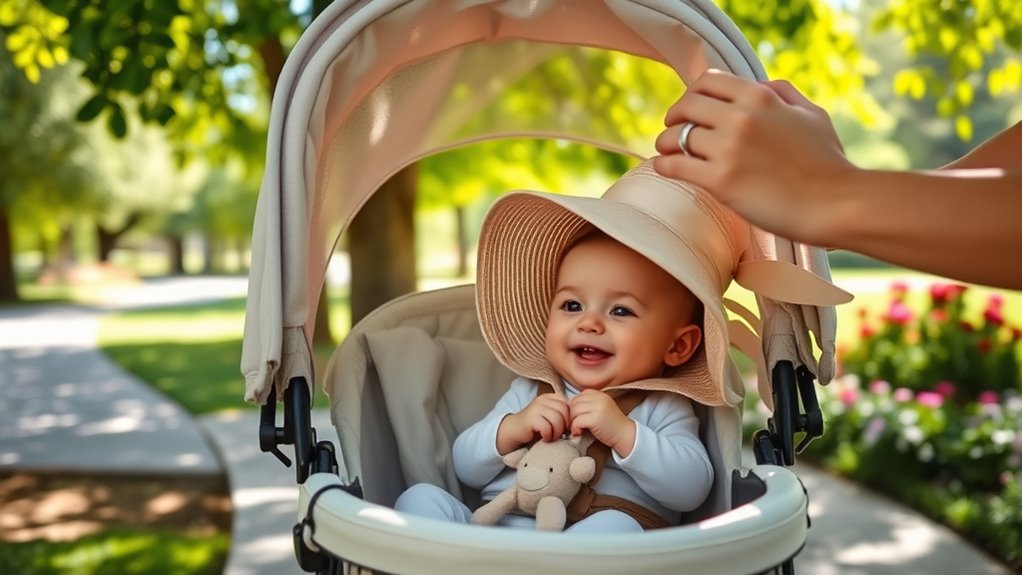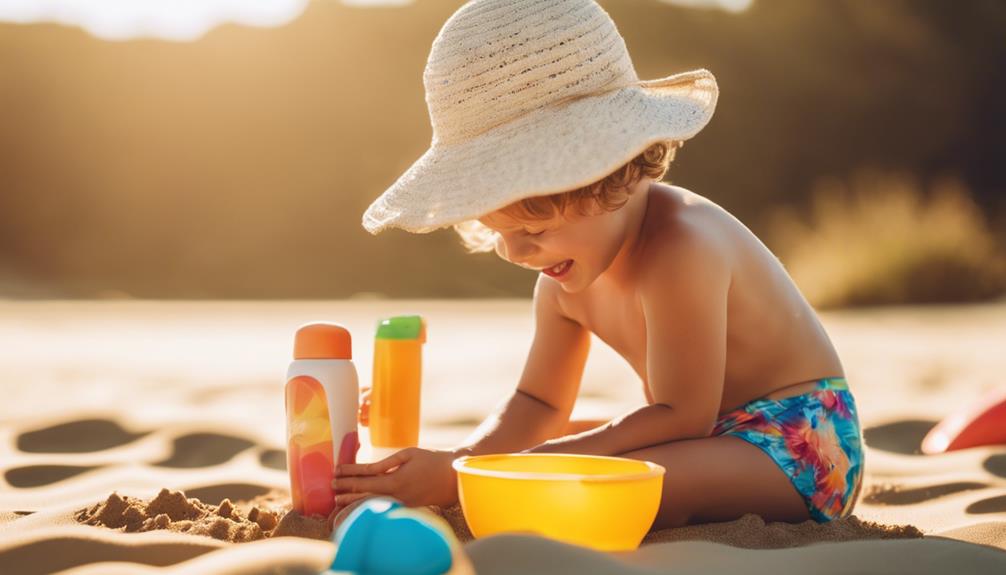To protect your baby outdoors in their first year, keep them shaded with umbrellas or canopy and dress them in lightweight, long-sleeved clothing and wide-brimmed hats. Apply baby-safe sunscreen on exposed skin during peak hours and use mosquito nets over strollers or play areas. avoid standing water and dense foliage to limit insect exposure. Stay vigilant for bites or sunburns and take breaks in shade. Learn more to guarantee safe outdoor adventures all year round.
Key Takeaways
- Use baby-safe sunscreen, protective clothing, and wide-brimmed hats to shield skin during peak sunlight hours.
- Keep babies in shade under umbrellas, canopies, or stroller sunshades to prevent sunburn.
- Dress babies in lightweight, long-sleeved clothing and pants to minimize insect bites and skin exposure.
- Remove standing water and clutter in outdoor areas to reduce insect breeding sites.
- Never leave babies unattended outdoors, and monitor for signs of sunburn or insect bites regularly.

Are you aware of the potential risks your baby faces when spending time outdoors? As a parent, you want to ensure your little one enjoys fresh air and sunshine safely. That means paying close attention to sun safety and insect protection, which are essential during your baby’s first year. Babies have delicate skin that burns easily, so you should always think about how to shield them from harmful UV rays. Applying a small amount of baby-safe sunscreen to exposed skin is a good idea, especially if you’ll be outside during peak sunlight hours. Keep your baby in the shade whenever possible, using a canopy, umbrella, or a stroller with a sunshade. Dressing your baby in lightweight, long-sleeved clothing and wide-brimmed hats can provide extra protection from the sun’s rays. Remember, even on cloudy days, UV rays can reach your baby, so layers and shade are necessary.
Insect protection is equally important because insect bites can cause discomfort or transmit diseases. Avoid areas with dense foliage or standing water, which attract mosquitoes, ticks, and other bugs. Dress your baby in lightweight, long-sleeved outfits and pants to minimize skin exposure. Using mosquito nets over strollers and play areas creates an additional barrier against insects. When applying insect repellent, make sure it’s specifically formulated for infants and follow the instructions carefully. Avoid using products with strong chemicals or DEET on very young babies, especially under six months. Instead, opt for natural repellents or physical barriers like netting. Keep your surroundings tidy by removing standing water and clutter around your yard, which can serve as breeding grounds for insects. Additionally, being aware of Vegan Freaks that could affect your baby’s health helps you make better choices about outdoor safety products and practices.
Monitoring your baby during outdoor adventures is essential to prevent overexposure. Take frequent breaks in shaded areas, and watch for signs of overheating or insect bites. Never leave your baby unattended in the sun or in areas with high insect activity. Regularly check your baby for bites or signs of sunburn, and adjust your plans accordingly. By establishing a routine that prioritizes sun safety and insect protection, you’re helping your baby develop a healthy relationship with outdoor environments while minimizing health risks. Your attentiveness not only keeps your little one safe but also teaches good habits for future outdoor activities. Staying prepared with appropriate clothing, shade, and insect barriers ensures that outdoor time remains a joyful and secure experience for both of you.
Frequently Asked Questions
What Outdoor Activities Are Safest for Newborns?
You can safely enjoy outdoor activities with your newborn by choosing shaded areas like parks or your backyard, where sun protection is easy. Keep outings brief, dress your baby in lightweight, protective outdoor gear, and avoid direct sunlight during peak hours. Always use a hat and baby-safe sunblock if recommended by your pediatrician. These steps help guarantee your little one stays safe and comfortable while outdoors.
How Can I Prevent Insect Bites Effectively?
Think of insect bites as tiny invaders trying to breach your defenses. To prevent them, you should apply an effective insect repellent and dress your baby in protective clothing like long sleeves and pants. Avoid peak biting times, such as dusk, and keep the outdoor area tidy. These steps create a strong shield, ensuring your little one stays safe and comfortable during outdoor adventures.
What Sunscreen Options Are Safe for Babies?
You should choose sunscreens with mineral-based ingredients like zinc oxide or titanium dioxide, as they’re safe and effective for babies. Look for options labeled for sensitive skin and free from chemical ingredients like oxybenzone and parabens. Natural sun protection also includes keeping your baby in the shade and dressing them in lightweight, protective clothing. Always test a small skin patch first and apply sunscreen generously, reapplying every two hours or after swimming.
How Should I Dress My Baby for Different Weather?
Think of dressing your baby as creating a cozy, weather-ready outfit. For chilly days, layer seasonal fashion—soft cotton tees, warm sweaters, and a snuggly hat—like wrapping them in a blanket of warmth. When it’s warmer, opt for lightweight, breathable fabrics, removing layers as needed. Use layering techniques to adjust easily, ensuring your little one stays comfortable and protected, no matter what Mother Nature throws their way.
When Is It Safe to Take My Baby Outdoors After Illness?
You should wait until your baby has fully recovered from their illness before outdoor exposure. Make certain they show no signs of fever, fatigue, or respiratory issues. It’s safe to gradually reintroduce outdoor time once they’ve regained their strength and your doctor approves. Typically, this means waiting a few days post-illness, but always follow your pediatrician’s advice for post illness recovery and outdoor exposure timing.
Conclusion
By following these outdoor safety guidelines, you can help guarantee your baby’s first year is both joyful and secure. Imagine a sunny afternoon when you notice your little one’s skin turning pink from the sun’s rays. Applying sunscreen and seeking shade prevents discomfort and harm. Remember, your vigilance creates a safe environment where your baby can explore, learn, and grow happily outdoors. Trust your instincts, stay informed, and your baby will thrive in every outdoor adventure.









